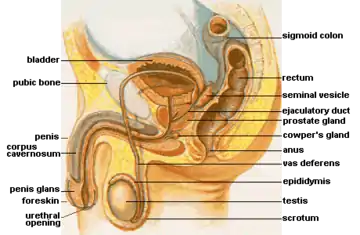Foreskin
The foreskin is the double-layered fold of smooth muscle tissue, blood vessels, neurons, skin, and mucous membrane part of the penis that covers and protects the glans penis and the urinary meatus.[1] The foreskin is mobile, fairly stretchable, and acts as a natural lubricant. It is also described as the prepuce, a technically broader term that also includes the clitoral hood in women, to which the foreskin is embryonically homologous.
| Foreskin | |
|---|---|
 Foreskin partially retracted over the glans penis | |
| Details | |
| Precursor | Genital tubercle, urogenital folds |
| Artery | Dorsal artery of the penis |
| Vein | Dorsal veins of the penis |
| Nerve | Dorsal nerve of the penis |
| Identifiers | |
| Latin | Praeputium |
| MeSH | D052816 |
| TA98 | A09.4.01.011 |
| TA2 | 3675 |
| FMA | 19639 |
| Anatomical terminology | |
The foreskin of adults is typically retractable over the glans. Coverage of the glans in a flaccid and erect state varies depending on foreskin length. The foreskin is attached to the glans at birth and is generally not retractable in infancy. Inability to retract the foreskin in childhood should not be considered a problem unless there are other symptoms.[2] The highly innervated mucocutaneous zone of the penis occurs near the tip of the foreskin.
The foreskin may become subject to a number of pathological conditions.[3] Most conditions are rare and are easily treated. In some cases, particularly with chronic conditions, treatment may include circumcision, a procedure where the foreskin is partially or completely removed.
Description

The outside of the foreskin is a continuation of the skin on the shaft of the penis, but the inner foreskin is a mucous membrane like the inside of the eyelid or the mouth. The mucocutaneous zone occurs where the outer and inner foreskin meet. Like the eyelid, the foreskin is free to move after it separates from the glans, which usually occurs before or during puberty. The foreskin is attached to the glans by a frenulum, a highly vascularized tissue of the penis.[4] The World Health Organization states that "[t]he frenulum forms the interface between the outer and inner foreskin layers, and when the penis is not erect, it tightens to narrow the foreskin opening.[4]
The human foreskin contains a sheath of muscle tissue just below the skin, formerly known as the peripenic muscle and now called the dartos fascia, most of which is contained in the foreskin. Elastic fibers are contained in the dartos fascia, which form a whorl at the tip of the foreskin. The whorl of fibers acts as a sphincter in infants, which opens to allow the passage of urine, but closes to protect the glans penis from foreign matter and contaminants. The dartos fascia is sensitive to temperature and expands and contracts with temperature changes. The dartos fascia is only loosely connected with the underlying tissue so it provides the skin mobility and elasticity of the penile skin.
According to the histological findings of the British Association of Urological Surgeons based on a research conducted on the autopsy of 22 foreskins, "the prepuce provides a large and important platform for several nerves and nerve endings",[5] The College of Physicians and Surgeons of British Columbia has written that the foreskin is "composed of an outer skin and an inner mucosa that is rich in specialized sensory nerve endings and erogenous tissue."[6]
Langerhans cells are immature dendritic cells that are found in all areas of the penile epithelium,[7] but are most superficial in the inner surface of the foreskin.[7]
Development
The foreskin is present in non-human primates, including the chimpanzee.[4]
Eight weeks after fertilization, the foreskin begins to grow over the head of the penis, covering it completely by 16 weeks. At this stage, the foreskin and glans share an epithelium (mucous layer) that fuses the two together. It remains this way until the foreskin separates from the glans.

In children, the foreskin usually covers the glans completely but in adults it may not. During erection, the degree of automatic foreskin retraction varies considerably; in some adults, the foreskin remains covering all or some of the glans until retracted manually or by sexual activity. This variation was regarded by Chengzu (2011) as an abnormal condition named 'prepuce redundant'. Frequent retraction and washing under the foreskin is suggested for all adults but particularly for those with a long, or 'redundant' foreskin.[8] When the foreskin is longer than the erect penis, it will not spontaneously retract upon erection.
It is shown that manual foreskin retraction during childhood or even adulthood serves as a stimulant to normal development and automatic retraction of the foreskin, which suggests that many conditions affecting the foreskin may be prevented or cured behaviorally. Some males, according to Xianze (2012), may be reluctant for their glans to be exposed because of discomfort when it chafes against clothing, although the discomfort on the glans was reported to diminish within one week of continuous exposure.[9] Guochang (2010) states that for those whose foreskins are too tight to retract or have some adhesions, forcible retraction should be avoided since it may cause injury.[10]
Functions

The World Health Organization (2007) states that there is "debate about the role of the foreskin, with possible functions including keeping the glans moist, protecting the developing penis in utero, or enhancing sexual pleasure due to the presence of nerve receptors".[4] The foreskin helps to provide sufficient skin during an erection.
The foreskin protects the glans.[6] The foreskin protects the glans of infants from ammonia and feces in diapers, which reduces the incidence of meatal stenosis, and continues to protect the glans from abrasions and trauma throughout life. The fold of the prepuce maintains sub-preputial wetness, which mixes with exfoliated skin to form smegma.
The American Academy of Pediatricians' 2012 technical report on circumcision found that the foreskin tends to harbor micro-organisms that can lead to urinary tract infections in infants and tend to contribute to the transmission of sexually transmitted infections in adults.[12]
Sensitivity
The foreskin is specialized tissue that is packed with nerves and stretch receptors.[13] The foreskin contains Meissner's corpuscles, which are nerve endings involved in fine-touch sensitivity. Compared to other hairless skin areas on the body, the Meissner's index was highest in the finger tip (0.96) and lowest in the foreskin (0.28). The foreskin is the least sensitive hairless tissue of the body. A study also found that "the number of these nerve endings decreases significantly after the teenage to young adult years when sexual activity begins. This makes it very difficult to propose any sexual function for Meissner's corpuscles. A more feasible hypothesis is to regard them as a juvenile phenomenon, perhaps serving to protect the penis until the onset of puberty reveals its sexual function."[14] Charles Darwin speculated that the sensitivity of the foreskin to fine touch might have served as an "early warning system" in our naked ancestors while it protected the glans from the intrusion of biting insects and parasites.[15]
In 1996, following a study of 22 cadavers, retired pathologist John Taylor published an influential paper in which he proposed that the pleated skin of the foreskin was a distinct anatomical structure called the "ridged band", and that it played an important role in male sexual function.[16][17] A 2015 review by Cox and colleagues said that the feature was particular to some men and that illustrations of the "ridged band" had been inconsistent in what they pointed to.[14]
Moses and Bailey (1998), say that "it has not been demonstrated that [the foreskin] is associated with increased male sexual pleasure."[18] A 2015 study in sexual sensation concluded that the glans, not the foreskin, is involved in sexual sensation, particularly the corona and frenular (the area under the frenulum) areas.[14] Morris and Krieger state, "Thus, speculation and outdated opinion pieces claiming special properties of the foreskin, such as in penile function and masturbation, should be viewed with skepticism."[19] Contrary to popular belief and opinion, two studies conducted in 2013 that examined sexual penile sensitivity before and after circumcision both found higher penile sensitivity post circumcision. It was deduced that even a retracted foreskin would tend to reduce the stimulus to the corona and frenular areas, particularly on the outward stroke of intercourse. However, both studies concluded that there were no significant differences in sexual function between circumcised and uncircumcised men.[20][21] The 2015 study determined that "any sexual effect of circumcision must depend solely on the exposure of the glans and not on the absence of the prepuce."[14] The study concluded that male circumcision has no adverse effect on parameters relevant to sexual function, sensation, sensitivity, satisfaction, or pleasure.[14]
The World Health Organization (2007) states that "Although it has been argued that sexual function may diminish following circumcision due to the removal of the nerve endings in the foreskin and subsequent thickening of the epithelia of the glans, there is little evidence for this and studies are inconsistent."[4] There is controversy about whether the epithelium of the glans of an uncircumcised penis is keratinised; some authors claim that it is not,[22] while one study examined the glans of seven circumcised and six uncircumcised men and found the epithelia to be equally keratinised.[23]
The Royal Dutch Medical Association (2010) states that many sexologists view the foreskin as "a complex, erotogenic structure that plays an important role 'in the mechanical function of the penis during sexual acts, such as penetrative intercourse and masturbation'."[24] In 2010 the same association called non-therapeutic male circumcision a harmful and painful ritual that violates children's rights.[25]
Evolution
In primates, the foreskin is present in the genitalia of both sexes and likely has been present for millions of years of evolution.[26] The evolution of complex penile morphologies like the foreskin may have been influenced by females.[27][28][29]
In modern times, there is controversy regarding whether the foreskin is a vital or vestigial structure.[30] In 1949, British physician Douglas Gairdner noted that the foreskin plays an important protective role in newborns. He wrote, "It is often stated that the prepuce is a vestigial structure devoid of function... However, it seems to be no accident that during the years when the child is incontinent the glans is completely clothed by the prepuce, for, deprived of this protection, the glans becomes susceptible to injury from contact with sodden clothes or napkin."[30] During the physical act of sex, the foreskin reduces friction, which can reduce the need for additional sources of lubrication.[30] "Some medical researchers, however, claim circumcised men enjoy sex just fine and that, in view of recent research on HIV transmission, the foreskin causes more trouble than it’s worth."[30] The area of the outer foreskin measures 7–100 cm2,[31] and the inner foreskin measures 18–68 cm2,[32] which is a wide range. Regarding vestigial structures, Charles Darwin wrote, "An organ, when rendered useless, may well be variable, for its variations cannot be checked by natural selection."[15] In the March 2017 publication of the Global Health Journal: Science and Practice, Morris and Krieger wrote, "The variability in foreskin size is consistent with the foreskin being a vestigial structure."[19]
Conditions
The foreskin can be involved in balanitis, phimosis, sexually transmitted infection and penile cancer.[33]
Frenulum breve is a frenulum that is insufficiently long to allow the foreskin to fully retract, which may lead to discomfort during intercourse.
Phimosis is a condition where the foreskin of an adult cannot be retracted properly. Phimosis can be treated by using topical steroid ointments and using lubricants during sex; for severe cases circumcision may be necessary.[2] Posthitis is an inflammation of the foreskin.
A condition called paraphimosis may occur if a tight foreskin becomes trapped behind the glans and swells as a restrictive ring. This can cut off the blood supply, resulting in ischemia of the glans penis.[2]
Lichen sclerosus is a chronic, inflammatory skin condition that most commonly occurs in adult women, although it may also be seen in men and children. Topical clobetasol propionate and mometasone furoate were proven effective in treating genital lichen sclerosus.[34]
Some birth defects of the foreskin can occur; all of them are rare. In aposthia there is no foreskin at birth,[35]:37–39 in micropathia the foreskin does not cover the glans,[35]:41–45 and in macroposthia, also called and congenital megaprepuce, the foreskin extends well past the end of the glans.[35]:47–50
It has been found that larger foreskins place uncircumcised men at an increased risk for HIV infection[36] most likely due to the larger surface area of inner foreskin and the high concentration of Langerhans cells.[23]
Modifications

Fig 1. Penis with tight phimotic ring making it difficult to retract the foreskin.
Fig 2. Foreskin retracted under anaesthetic with the phimotic ring or stenosis constricting the shaft of the penis and creating a "waist".
Fig 3. Incision closed laterally.
Fig 4. Penis with the loosened foreskin replaced over the glans.
Preputioplasty is the most common foreskin reconstruction technique, most often done when a boy is born with a foreskin that is too small;[37]:177 a similar procedure is performed to relieve a tight foreskin without resorting to circumcision.[37]:181
Circumcision is the removal of the foreskin, either partially or completely. For newborns, it may be done for religious requirements or personal preferences surrounding hygiene and aesthetics.[38]:257 Circumcision may also be performed on children or adults to treat phimosis, balanitis, or to prevent transmission of sexually transmitted infections.[39]:166 As of 2012 no successful technique to reconstruct a circumcised foreskin had been published.[37]:181 Some men have used weights to stretch the skin of the penis to regrow a foreskin; the resulting tissue does cover the glans but does not replicate the features of a foreskin.[40]
Other cultural or aesethetic practices include genital piercings involving the foreskin and slitting the foreskin.[41]
Foreskin-based products

Foreskins obtained from circumcision procedures are frequently used by biochemical and micro-anatomical researchers to study the structure and proteins of human skin. In particular, foreskins obtained from newborns have been found to be useful in the manufacturing of more human skin.[42]
Foreskins of babies are also used for skin graft tissue,[43][44][45] and for β-interferon-based drugs.[46]
Foreskin fibroblasts have been used in biomedical research.[47]
History
The foreskin can be seen depicted in art from different ages.
 David Marble sculpture, 1504 A.D.
David Marble sculpture, 1504 A.D. "Orestes at Delphi". Painting of two naked males, ca. 330 B.C.
"Orestes at Delphi". Painting of two naked males, ca. 330 B.C. The Marathon Youth, National Archaeological Museum, Athens, ca. 340-330 B.C.
The Marathon Youth, National Archaeological Museum, Athens, ca. 340-330 B.C.
References
- Kirby R, Carson C, Kirby M (2009). Men's Health (3rd ed.). New York: Informa Healthcare. p. 283. ISBN 978-1-4398-0807-8. OCLC 314774041.
- "Phimosis (tight foreskin)". NHS Choices. 26 August 2015. Retrieved 21 September 2017.
- Shah M (January 2008). The Male Genitalia: A Clinician's Guide to Skin Problems and Sexually Transmitted Infections. Radcliffe Publishing. pp. 37–. ISBN 978-1-84619-040-7.
- "Male circumcision: Global trends and determinants of prevalence, safety and acceptability" (PDF). World Health Organization. 2007.
- Taylor JR, Lockwood AP, Taylor AJ (February 1996). "The prepuce: specialized mucosa of the penis and its loss to circumcision". British Journal of Urology. 77 (2): 291–5. doi:10.1046/j.1464-410X.1996.85023.x. PMID 8800902.
- College of Physicians; Surgeons of British Columbia (2009). "Circumcision (Infant Male)" (PDF). Archived from the original (PDF) on May 31, 2012. Retrieved April 22, 2012.
- McCoombe SG, Short RV (July 2006). "Potential HIV-1 target cells in the human penis". AIDS. 20 (11): 1491–5. doi:10.1097/01.aids.0000237364.11123.98. PMID 16847403. S2CID 22839409.
- Chengzu L (2011). "Health Care for Foreskin Conditions". Epidemiology of Urogenital Diseases. Beijing: People's Medical Publishing House.
- Xianze L (2012). Tips on Puberty Health. Beijing: People's Education Press.
- Guochang H (2010). General Surgery. Beijing: People's Medical Publishing House.
- American Academy of Pediatrics Task Force on Circumcision (September 2012). "Male circumcision". Pediatrics. 130 (3): e756-85. doi:10.1542/peds.2012-1990. PMID 22926175.. The technical report was published in conjunction with an updated statement of policy on circumcision: American Academy of Pediatrics Task Force on Circumcision (September 2012). "Circumcision policy statement" (PDF). Pediatrics. 130 (3): 585–6. doi:10.1542/peds.2012-1989. PMID 22926180. S2CID 207166111.
- Bullough VL, Bullough B (14 January 2014). Human Sexuality: An Encyclopedia. Routledge. pp. 120–. ISBN 978-1-135-82502-7.
- Cox G, Krieger JN, Morris BJ (June 2015). "Histological Correlates of Penile Sexual Sensation: Does Circumcision Make a Difference?". Sexual Medicine. 3 (2): 76–85. doi:10.1002/sm2.67. PMC 4498824. PMID 26185672.
- Darwin C (1859). The Origin of Species by Means of Natural Selection. London, UK: John Murray.
- Baky Fahmy MA (2020). Normal and Abnormal Prepuce. Springer Nature. p. 45. ISBN 978-3-030-37621-5.
- Milne, Celia (December 5, 2000). "The Circumcision Debate". The Globe And Mail. Retrieved November 16, 2020.
- Moses S, Bailey RC, Ronald AR (October 1998). "Male circumcision: assessment of health benefits and risks". Sexually Transmitted Infections. 74 (5): 368–73. doi:10.1136/sti.74.5.368. PMC 1758146. PMID 10195035.
There is indirect evidence suggesting that the foreskin may have an important sensory function, although aside from anecdotal reports, it has not been demonstrated that this is associated with increased male sexual pleasure.
- Morris BJ, Krieger JN, Klausner JD (March 2017). "CDC's Male Circumcision Recommendations Represent a Key Public Health Measure". Global Health, Science and Practice. 5 (1): 15–27. doi:10.9745/GHSP-D-16-00390. PMC 5478224. PMID 28351877.
- Morris BJ, Krieger JN (November 2013). "Does male circumcision affect sexual function, sensitivity, or satisfaction?--a systematic review". The Journal of Sexual Medicine. 10 (11): 2644–57. doi:10.1111/jsm.12293. PMID 23937309.
- Tian Y, Liu W, Wang JZ, Wazir R, Yue X, Wang KJ (September 2013). "Effects of circumcision on male sexual functions: a systematic review and meta-analysis". Asian Journal of Andrology. 15 (5): 662–6. doi:10.1038/aja.2013.47. PMC 3881635. PMID 23749001.
- Barreto J, Caballero C, Cubilla A (1997). "Penis". In Sternberg SS (ed.). Histology for pathologists (2nd ed.). Philadelphia: Lippincott-Raven.
- Szabo R, Short RV (June 2000). "How does male circumcision protect against HIV infection?". BMJ (Clinical Research Ed.). 320 (7249): 1592–4. doi:10.1136/bmj.320.7249.1592. PMC 1127372. PMID 10845974.
- "Non-therapeutic circumcision of male minors (2010)". KNMG. 12 June 2010.
- Cowan R (23 September 2011). "Dutch doctors urge end to male circumcision". Reuters.
- Martin RD (1990). Primate Origins and Evolution: A Phylogenetic Reconstruction. New Jersey: Princeton University Press. ISBN 978-0-691-08565-4.
- Diamond JM (1997). Why Sex is Fun: The Evolution of Human Sexuality. London: Weidenfeld & Nicolson. ISBN 978-0-465-03126-9.
- Darwin C (1871). The Descent of Man and Selection in Relation to Sex. London: Murray. ISBN 978-1-148-75093-4.
- Short RV (1981). "Sexual selection in man and the great apes". In Graham CE (ed.). Reproductive Biology of the Great Apes: Comparative and Biomedical Perspectives. New York: Academic Press. ISBN 9780323149716.
- Collier R (November 2011). "Vital or vestigial? The foreskin has its fans and foes". CMAJ. 183 (17): 1963–4. doi:10.1503/cmaj.109-4014. PMC 3225416. PMID 22025652.
- Kigozi G, Wawer M, Ssettuba A, Kagaayi J, Nalugoda F, Watya S, et al. (October 2009). "Foreskin surface area and HIV acquisition in Rakai, Uganda (size matters)". AIDS. 23 (16): 2209–13. doi:10.1097/QAD.0b013e328330eda8. PMC 3125976. PMID 19770623.
- Werker PM, Terng AS, Kon M (September 1998). "The prepuce free flap: dissection feasibility study and clinical application of a super-thin new flap". Plastic and Reconstructive Surgery. 102 (4): 1075–82. doi:10.1097/00006534-199809040-00024. PMID 9734426. S2CID 37976399.
- Simmons MN, Jones JS (May 2007). "Male genital morphology and function: an evolutionary perspective". The Journal of Urology. 177 (5): 1625–31. doi:10.1016/j.juro.2007.01.011. PMID 17437774.
- Chi CC, Kirtschig G, Baldo M, Brackenbury F, Lewis F, Wojnarowska F (December 2011). "Topical interventions for genital lichen sclerosus". The Cochrane Database of Systematic Reviews (12): CD008240. doi:10.1002/14651858.CD008240.pub2. PMC 7025763. PMID 22161424.
- Fahmy M (2017). Congenital Anomalies of the Penis – Springer. Springer. ISBN 978-3-319-43310-3.
- Van Howe RS, Sorrells MS, Snyder JL, Reiss MD, Milos MF (December 2016). "Letter from Van Howe et al Re: Examining Penile Sensitivity in Neonatally Circumcised and Intact Men Using Quantitative Sensory Testing: Bossio JA, Pukall CF, Steele SS; J Urol 2016;195:1848-1853". The Journal of Urology. 196 (6): 1824. doi:10.1016/j.juro.2016.05.127. PMID 28181790.
- Snodgrass WT (2012). "Chapter 15: Foreskin Reconstruction". In Bolnick DA, Koyle M, Yosha A (eds.). Surgical Guide to Circumcision. London: Springer-Verlag. pp. 177–181. ISBN 978-1-4471-2858-8.
- Cox G, Morris BJ (2012). "Chapter 21: Why Circumcision:From Prehistory to the Twenty-First Century". In Bolnick DA, Koyle M, Yosha A (eds.). Surgical Guide to Circumcision. London: Springer-Verlag. pp. 243–259. ISBN 978-1-4471-2858-8.
- McClung C, Voelzke B (2012). "Chapter 14: Adult Circumcision". In Bolnick DA, Koyle M, Yosha A (eds.). Surgical Guide to Circumcision. London: Springer-Verlag. pp. 165–175. ISBN 978-1-4471-2858-8.
- Collier R (December 2011). "Whole again: the practice of foreskin restoration". CMAJ. 183 (18): 2092–3. doi:10.1503/cmaj.109-4009. PMC 3255154. PMID 22083672.
- "Paraphimosis : Article by Jong M Choe, MD, FACS". eMedicine. Retrieved 2012-07-16.
- McKie R (1999-04-04). "Foreskins for Skin Grafts". The Toronto Star.
- "High-Tech Skinny on Skin Grafts". 1999-02-16. Archived from the original on October 10, 2008. Retrieved 2008-08-20.
- Grand DJ (August 15, 2011). "Skin Grafting". Medscape. Retrieved August 18, 2012.
- Amst C, Carey J (July 27, 1998). "Biotech Bodies". www.businessweek.com. The McGraw-Hill Companies Inc. Archived from the original on December 24, 2013. Retrieved 2017-09-17.CS1 maint: bot: original URL status unknown (link)
- Cowan AL (April 19, 1992). "Wall Street; A Swiss Firm Makes Babies Its Bet". New York Times:Business. New York Times. Retrieved 2008-08-20.
- Hovatta O, Mikkola M, Gertow K, Strömberg AM, Inzunza J, Hreinsson J, et al. (July 2003). "A culture system using human foreskin fibroblasts as feeder cells allows production of human embryonic stem cells". Human Reproduction. 18 (7): 1404–9. doi:10.1093/humrep/deg290. PMID 12832363.
External links
| Wikimedia Commons has media related to Foreskin. |
- Foreskin.org – Many detailed pictures of the human male foreskin
- Infant foreskin care at Kidshealth.org.nz
- "Care for an Uncircumcised Penis". Healthy Children. American Academy of Pediatrics. 19 June 2017. Retrieved 9 September 2018.
- Management of foreskin conditions – Statement from the British Association of Paediatric Urologists on behalf of the British Association of Paediatric Surgeons and The Association of Paediatric Anaesthetists (2007).